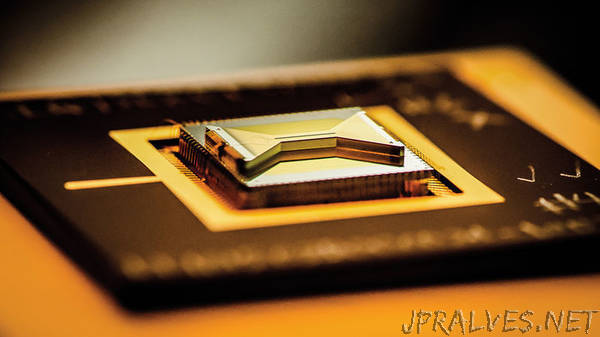
“The U.S. Department of Energy (DOE) is joining the quest to develop quantum computers, devices that would exploit quantum mechanics to crack problems that overwhelm conventional computers. The initiative comes as Google and other companies race to build a quantum computer that can demonstrate “quantum supremacy” by beating classical computers on a test problem. But reaching that milestone will not mean practical uses are at hand, and the new $40 million DOE effort is intended to spur the development of useful quantum computing algorithms for its work in chemistry, materials science, nuclear physics, and particle physics.
“We are looking for algorithms that can advance the science,” says Stephen Binkley, acting director of DOE’s $5.4 billion Office of Science in Washington, D.C., who in a 29 November 2017 open letter urged researchers to submit proposals for such work.
The U.S. government already spends about $250 million per year on quantum computing, mostly through the Army Research Office, says Christopher Monroe, a physicist at the University of Maryland in College Park and co-founder of the quantum computing startup IonQ. But the DOE money will go mostly to its national laboratories. Monroe says researchers there can play a leading role in developing the machines. “Industry can’t do it because they don’t have the people, and academics can’t do it because they don’t build things.”
Whereas a conventional computer manipulates bits that can be set to either 0 or 1, a quantum computer employs quantum bits or qubits that, bizarrely, can be set to 0 and 1 at the same time. A qubit can be a patch of superconducting metal that can be electrically charged to encode 1, uncharged to encode 0, or both charged and uncharged at the same time. Trapped ions, which can spin in opposite directions or both ways at once, can also serve as qubits. With their two-ways-at once capability, just 300 qubits could simultaneously encode more numbers than there are atoms in the observable universe.
However, it is the way quantum computers solve problems that accounts for their power—and their limitations. Problems can be encoded so that potential solutions correspond to different quantum waves sloshing through the qubits. Set things up so the waves interfere the right way, and the wrong solutions will cancel one another while the right solution pops out. That’s how a quantum computer could quickly factor large numbers, potentially enabling it to crack current internet encryption protocols. But the approach cannot aid every computation.
For instance, quantum computers won’t help analyze the billions of records of individual particle collisions produced by atom smashers such as the Large Hadron Collider in Switzerland, says James Amundson, a computational physicist at Fermi National Accelerator Laboratory in Batavia, Illinois. Each of the records is easy to analyze, so they need only to be fed through an army of ordinary computers working in parallel, Amundson says. A quantum computer can’t speed up the process.
Still, the machines hold great promise for some problems, researchers say, such as those that involve modeling or simulating inherently quantum mechanical processes. In chemistry, for example, enzymes called nitrogenases catalyze the reactions that enable nitrogen-fixing bacteria to turn nitrogen from the air into a form that plants can use. No conventional computer can calculate exactly how the process works, but a quantum computer could, says Wibe de Jong, a computational chemist at Lawrence Berkeley National Laboratory in Berkeley, California. “There are lots of catalytic processes that are still very hard to model because of the computational complexity,” he says.
Quantum computers might also aid in the design of materials from their atomic constituents on up. And they could help predict how the superdense matter in neutron stars behaves or how a proton breaks up during a particle collision. Such applications all involve the interplay of the quantum waves that describe subatomic particles. Tracking the oscillating waves swamps a conventional computer, but a quantum computer handles that aspect of a calculation automatically, explains Martin Savage, a nuclear theorist at the University of Washington in Seattle.
Researchers have only begun to figure out how to map such problems onto a quantum computer’s qubits. To speed the process, DOE in September 2017 launched two testbeds to enable designers and scientists to work together on approaches to quantum computation. At the Berkeley lab, physicist Irfan Siddiqi and colleagues aim to build their own 64-qubit quantum computer using superconducting qubits. Feedback from users will influence their designs, such has how the qubits are arranged and connected with one another on a chip, Siddiqi says.
In contrast, a testbed at Oak Ridge National Laboratory in Tennessee will provide remote access to existing machines at IBM and IonQ. That approach should spark the same sort of “co-design” without requiring Oak Ridge researchers to build a machine from scratch, says Raphael Pooser, a quantum information scientist at Oak Ridge. It also more closely resembles the way DOE develops its supercomputers in partnership with industry, he says.
In the meantime, commercial machines are getting more powerful. This week, researchers at Google’s laboratory in Santa Barbara, California, began testing a 50-qubit chip they think will achieve quantum supremacy, although the experiment could still take months. Yet some researchers worry that such a demonstration may mislead the public into thinking that scientists have reached the end of the road in developing a useful quantum computer. “It’s not even the beginning of the road,” Siddiqi says.
John Martinis, the physicist who leads Google’s effort, says the company “understands that quantum supremacy is a great milestone and that it will take longer, perhaps much longer, to make something practical.” DOE clearly agrees.”
